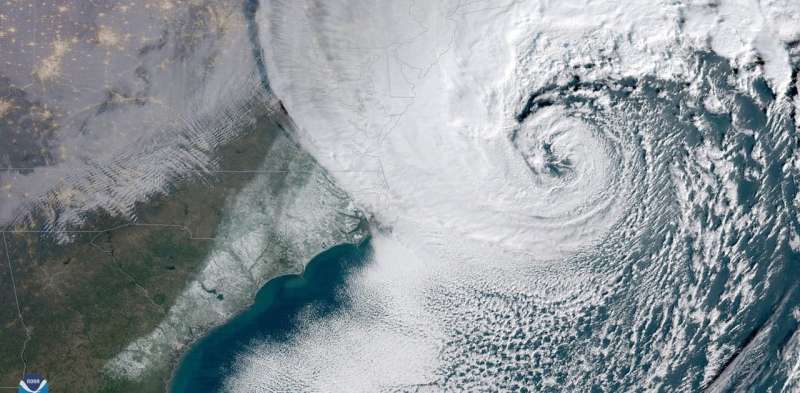'Bomb cyclones' – the intense winter storms that hit the US (and Australia too)

The eastern United States experienced a , which caused damaging winds, heavy snow and the . Meteorologists call this type of storm a "bomb cyclone", or simply a "bomb". But what is it?
A "bomb" is an old for a low-pressure system outside the tropics (that is, an extratropical cyclone) that intensifies very rapidly, based on how fast the atmospheric pressure drops at the centre of the storm. A common benchmark is a drop of 24 hectopascals (hPa) over 24 hours, although this varies slightly with latitude.
The recent bomb in the US had a reported pressure drop of , making it one of the strongest such storms ever recorded.
While it's the overall intensity that matters most for impacts like strong winds and storm surge, the rapid development of a bomb often makes it harder to forecast its exact intensity and timing. This in turn increases the risks to life and property.
What, where and why?
Just like a normal extratropical cyclone, a bomb gets its energy from variations in temperature, between the warmer temperatures towards the Equator and cooler temperatures towards the poles, as well as vertically through the atmosphere. This is different to tropical cyclones, which get their energy from very warm sea surface temperatures in the tropics.
During the cooler months the east coasts of continents are the perfect breeding grounds for bombs. The interaction between cold continental air and warm, moist ocean air provides lots of energy for a cyclone to develop. But compared with normal extratropical cyclones, bombs are much better at efficiently converting this potential energy into .
Bombs are most common in the winter, but can occur all year round, including systems that rapidly reform from a .

On average, there are about . About two-thirds are in the Northern Hemisphere, particularly off the east coasts of the US and Japan. Australia typically experiences several bombs each year, although they don't tend to intensify as rapidly as the recent US storm.
Many of the severe cyclones on Australia's east coast (known as East Coast Lows) meet the definition of a bomb. In December 1998, a brought tragedy to the Sydney-Hobart yacht race, . More recently an East Coast Low intensified very rapidly over – luckily, this was further from the coast than the cyclone that .
Explosive storm intensification can also occur around southern Australia. The storms and tornadoes that blacked out South Australia's electricity network in late September 2016 were related to a that brought very strong winds and high coastal sea levels to the state's southeast.
The future of bombs
, which means fewer winter cyclones in southern Australia. Trends in the strongest cyclones or bombs are less clear, but there is some indication that they have grown more frequent in recent decades, .
Northern Hemisphere studies suggest that bomb cyclones will also move towards the poles, although they might become .
Fewer studies have looked at projected changes in bombs in the Southern Hemisphere, but previous research has found that Australia's East Coast Lows are expected to become less frequent as a result of global warming, particularly during winter, which is when the bomb storms typically occur, while intense cyclones may become .
But remember: even if bombs become less frequent, increasing sea levels and atmospheric moisture can potentially worsen their impacts in the future.
Provided by The Conversation
This article was originally published on . Read the .![]()




















